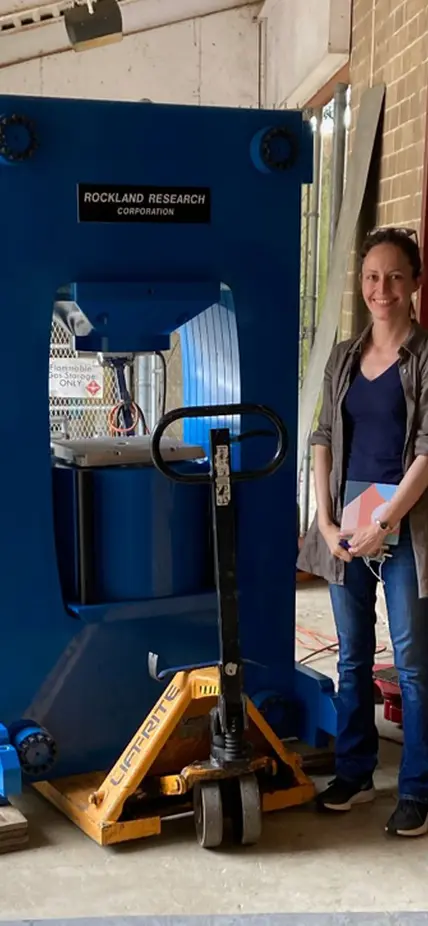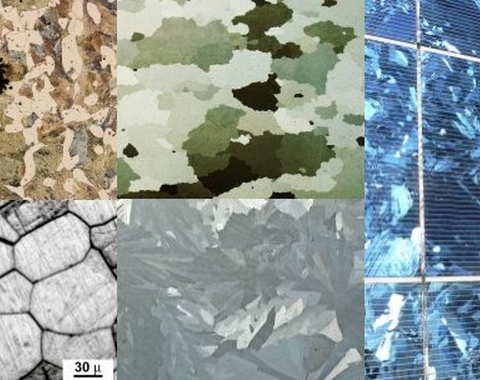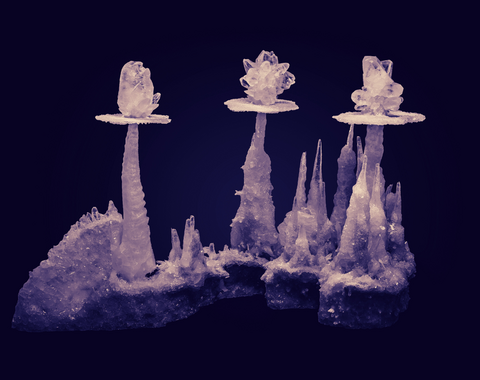In July 2021, Anne Pommier joined the Carnegie Science Earth and Planets Laboratory campus as a Staff Scientist, and she brought her specialized high-pressure lab with her!
What’s new in Pommier’s lab?
Scientists at the Earth and Planets Laboratory campus have access to a suite of instrumentation that includes multi-anvil presses, piston-cylinder presses, and specially built diamond anvil cells. These tools allow researchers to study materials at the high pressures and temperatures they might experience inside of a planet. For instance, by using a beveled diamond anvil cell, researchers can generate pressures as high as 400 GPa in the lab—allowing scientists to study materials’ behavior and chemistry at pressures they would experience in Earth’s core and beyond.
Pommier’s electrical conductivity experiments add a new facet to this type of research and they require specialized equipment, which she brought with her from San Diego. Her set-up includes the usual suspects expected in a high-pressure laboratory but with an electrifying twist. Her specially built multi-anvil press and piston-cylinder press can measure a material’s electric conductivity in real-time during Pommier’s high pressure and temperatures experiments.
Said Pommier, “It’s a very complementary set up to what is already in place at the Earth and Planets Laboratory.”
The presses arrived on campus in early July after a cross-country road trip. The largest press weighs in at about 11,500 pounds and can apply pressures higher than 20 GPa—about the pressure you’d expect to see at the core-mantle boundary of Mars. Higher pressure (40 GPa or so) can be reached by modifying the current setup, which is what fellow Staff Scientist Yingwei Fei uses in his experiments.
“With that technique, you could get to pressures equivalent to what you might find at the center of Mars or Mercury. So, you could study the entire range of these planets and smaller moons.”
Conductivity in action
Pommier’s investigation into the conductivity of minerals under pressure has several practical uses. When scientists measure electromagnetic activity in the field, they see “electrical anomalies” where the conductivity is higher or lower than the surrounding material. Magmas and aqueous fluids tend to stand out as huge, highly conductive anomalies—making them a clear target for conductivity studies.
Pommier’s work to understand melts and minerals’ electrical conductivity under different pressures and temperatures will allow scientists to compare these electromagnetic field measurements to lab collected conductivity data.
“We know the conductivity from the field measurements. But the big question is, ‘What is it?’ Under an active volcano, magma is expected—but what type of magma? At what temperature and depth is it stored? How much is there?” Pommier continued, “The electrical models we create in the lab will help identify the nature and storage conditions of magma in the crust and upper mantle.”
This real-world application of lab data will give geophysicists one more tool in their toolbox to understand what’s happening beneath a volcano.
Pommier’s current research also aims to understand the relationship between the conductivity and magnetic properties of planetary cores. Earth’s core is made of molten iron, which convects in a way that generates electric currents and creates our planet’s protective magnetic field—a phenomenon referred to by planetary scientists as a “dynamo.”
“How conductive the core is will help us understand its convection, how it releases heat, and therefore whether or not it can develop a dynamo and whether that dynamo can sustain a magnetic field long enough for life to be able to develop,” said Pommier.
New progress and experiments will have to wait as Pommier sets up the lab and calibrates the presses, and she’s eager to get started. However, what she’s most excited about is the opportunity for scientific collaboration on campus.
“The diversity of expertise in all the fields of Earth and planetary science is represented here, with a fantastic collaborative culture. It’s a unique environment for people who want to develop interdisciplinary projects—like me.”



